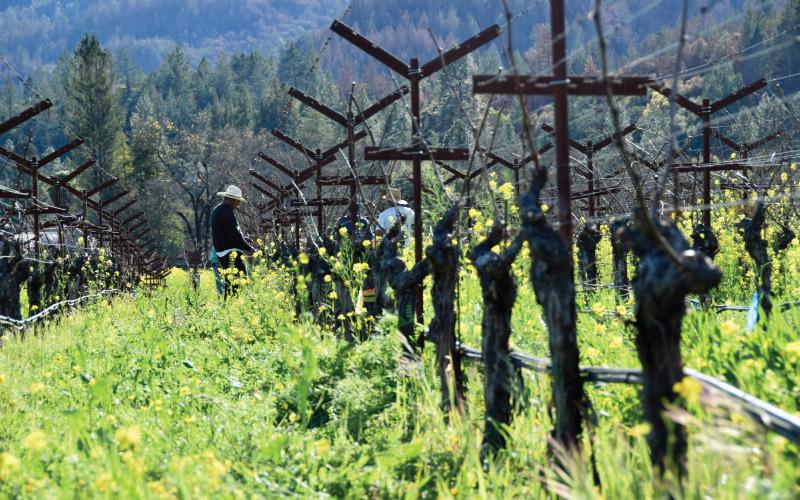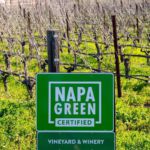
Napa Green, a nonprofit organization, has launched a next-level Napa Green Vineyard certification, the first sustainable winegrowing certification to focus specifically on climate action, regenerative farming and social equity and justice.
Napa Wineries Are Seeing Green
- GREEN LIVING Magazine | Carol Kahn |
- November 10, 2021
Napa Green, a nonprofit organization, has launched a next-level Napa Green Vineyard certification, the first sustainable winegrowing certification to focus specifically on climate action, regenerative farming and social equity and justice.
More and more consumers are turning towards sustainable and local options. In the wine industry, younger consumers are significantly engaged with sustainable wine, viewing it as increasingly important to protect the future. Taking a look at Gen Z and Millennials, they say that they are willing to trade convenience for environmental credentials.
As many are beginning to understand the terms “sustainability” and “eco-friendly,” these buzz words have been incorporated into our daily language generating a greater sense of understanding and knowledge of the importance in taking the initiative in protecting our planet. However, while consumers are now getting used to seeing labels and signage perpetuating sustainability, green, eco-friendly and organic, wineries are transitioning to become certified and sustainable which is a huge task.
Napa Green, a nonprofit organization, has launched a next-level Napa Green Vineyard certification, the first sustainable winegrowing certification to focus specifically on climate action, regenerative farming and social equity and justice. They have set the ambitious goal to work with certified growers to become carbon neutral within six years, and carbon negative, or climate positive, within nine years. The need for climate action is urgent and the cutting-edge Napa Green Vineyard standards provide growers with the guidance, tools, and support to take bold action and continue to be sustainability leaders.
Anna Brittain, Executive Director of Napa Green, says, “The growers in this world-renowned winegrowing region have a powerful collective platform. Our commitment to sustainability and climate action sets a standard that is recognized by the global wine industry, beverage sector, and marketplace. I grew up here, and I am incredibly proud to be working with our members to continue to push the envelope on sustainability.”
Brittain has been with Napa Green since 2015 when the organization wanted to do a big push among their members to have them all participating in the Napa Green Land and Napa Green Winery programs. She first was hired as a consultant then became executive director in 2019, when Napa Green became a nonprofit. She has been actively growing the program for almost seven years, but has been at the helm for the last two years.
Brittain has a master’s degree in environmental science and management, and her career as a consultant in sustainable winegrowing is very specialized. “I have worked with a statewide California Sustainable Winegrowing Alliance, helped Dom Perignon to develop their own wine standards and worked with a lot of individual wineries. Since 2015 my main work has been around Napa Green,” she said.
The new Napa Green Vineyard program is the first sustainable winegrowing certification to focus specifically on climate action, regenerative farming and social equity, justice and inclusion. Napa Green Vineyard certification provides a pathway for growers to improve soil health, become carbon neutral to negative within six to nine years, and increase the resilience of vineyards, businesses and our community.
Napa Green Certified Wineries focus on sustainability leadership & engagement, energy and water efficiency, waste reduction, pollution prevention, equity & community and storm & wastewater management. Making an exceptional wine requires stewardship and attention to detail. The same is true of achieving a Napa Green Winery certification.
The Napa Valley wine industry is already recognized as a global leader in both wine quality and sustainable winegrowing. Napa Green takes this to the next level and establishes rigorous standards for climate action and social equity. Sustainability rests on three pillars – Planet, People and Prosperity.
While this program has been going on for quite some time, there still are many challenges. “The good news is that I really feel like there is a renewed interest in sustainability right now and I think COVID helped. It got more people thinking ‘beyond my little world and my business, I have to think bigger’, so we didn’t have any lull in interest in certification during the pandemic,” Brittain said. “The biggest challenge is that we have 90 certified wineries and that’s quite a bit of sustainable wineries in California – about 40% of them are in Napa County.
Many of those who work at wineries wear multiple hats, which can, at times, be overwhelming and may need a lot of handholding. “We really are here to provide that [handholding] but it’s mostly getting people over that hurdle of feeling like, ‘I don’t know if I have the time or I don’t know if I have what it takes to move this across the line in terms of getting certified.’ So we really do try to provide as much help as we can as long as someone is committed to putting in that time,” Brittain said.
Brittain reiterates that the certification is not easy. There are over 100 stewardship standards to save energy and water, prevent waste through recycling and composting, reduce GHG emissions and the winery’s carbon footprint, and commit to social equity. “I think what is turning the tide more is that there is a huge market demand for this right now – in particular, a lot of wineries are exporting wines and there is a demand for this. Ontario, Japan, Scandinavian countries are asking if they have a sustainability certification and it affects their ability to get into that marketplace and there are domestic stores where that is true too,” Brittain said. “People are being asked if this is something that they have to do in order to remain competitive in the marketplace, and that is where we are getting more people coming to us.”
As part of the program, wineries, who are certified, are given huge metal signs to display at their entrance, which says they are Napa Green certified. “I had a few people call or email and say, I need to have one of those signs because everyone else has them, what do I have to do to get one of those?” Brittain said. “You can’t just order it.”
Among the growers already enrolled and committed to Napa Green Vineyard certification are Opus One Winery, Dominus Estate, Spottswoode Winery, Larkmead Vineyards, Cakebread Cellars, Raymond Vineyards, Burgess Cellars, Sequoia Grove, Antica Napa Valley, Trefethen Family Vineyards, Chimney Rock, Rutherford Hill and Tres Sabores.
Michael Silacci, winemaker for Opus One Winery, says, “Napa Green has been a blessing in disguise for the Napa Valley. The challenge made to us and to other participants was such that we called the bet for sustainability and raised it to stewardship. We’re on a roll, and together we are making this planet a better place, starting in the Napa Valley.
Earlier this year, a new Vineyard certification replaced the Napa Green Land program, which was established in 2004. The Land program drove the adoption of best practices to prevent erosion and sediment runoff, and improve the health of the Napa River and watershed. What were leading land stewardship practices have become general best practices that are now required for environmental regulatory compliance. The new Vineyard program embodies Napa Green’s commitment to evolve and grow regional sustainability and resilience to help solve the critical issues that face us now and in the future. Napa Green will be working with growers through this transition, with enrollment beginning this year and taking a year to fully adopt the new requirements.
“Sustainability is a journey of continuous improvement. As a community we want to be forward thinking and this certification is an exciting opportunity for Napa to drive the conversation around sustainability,” said Hailey Trefethen, executive vice president of Trefethen Family Vineyards and interim president of Napa Green board of directors.
The Napa Green website features “Champion Stories” to share in the success of those participating in the program. In one of the stories about ZD Wines, winemaker Chris Pisani says that being environmentally conscientious is part of the culture at ZD. “I remember a decade ago during bottling we had three large waste containers being hauled away every week. Almost everything was going to landfills,” Pisani said. Robert deLeuze, CEO of ZD Wines adds, “Today the only things that get collected are glass and pallets for recycling. Everyone on staff is trained to recycle.”
For more information on Napa Green visit, www.napagreen.org.
Making the commitment to third party certification takes time and effort, but it is worth it to demonstrate our commitment to the community and to protect our watershed, our land and the air we breathe.
- Susan Boswell, Chateau Boswell Winery


